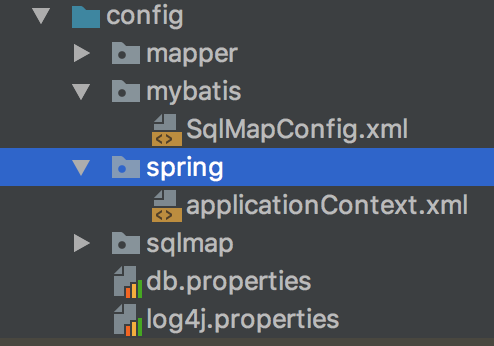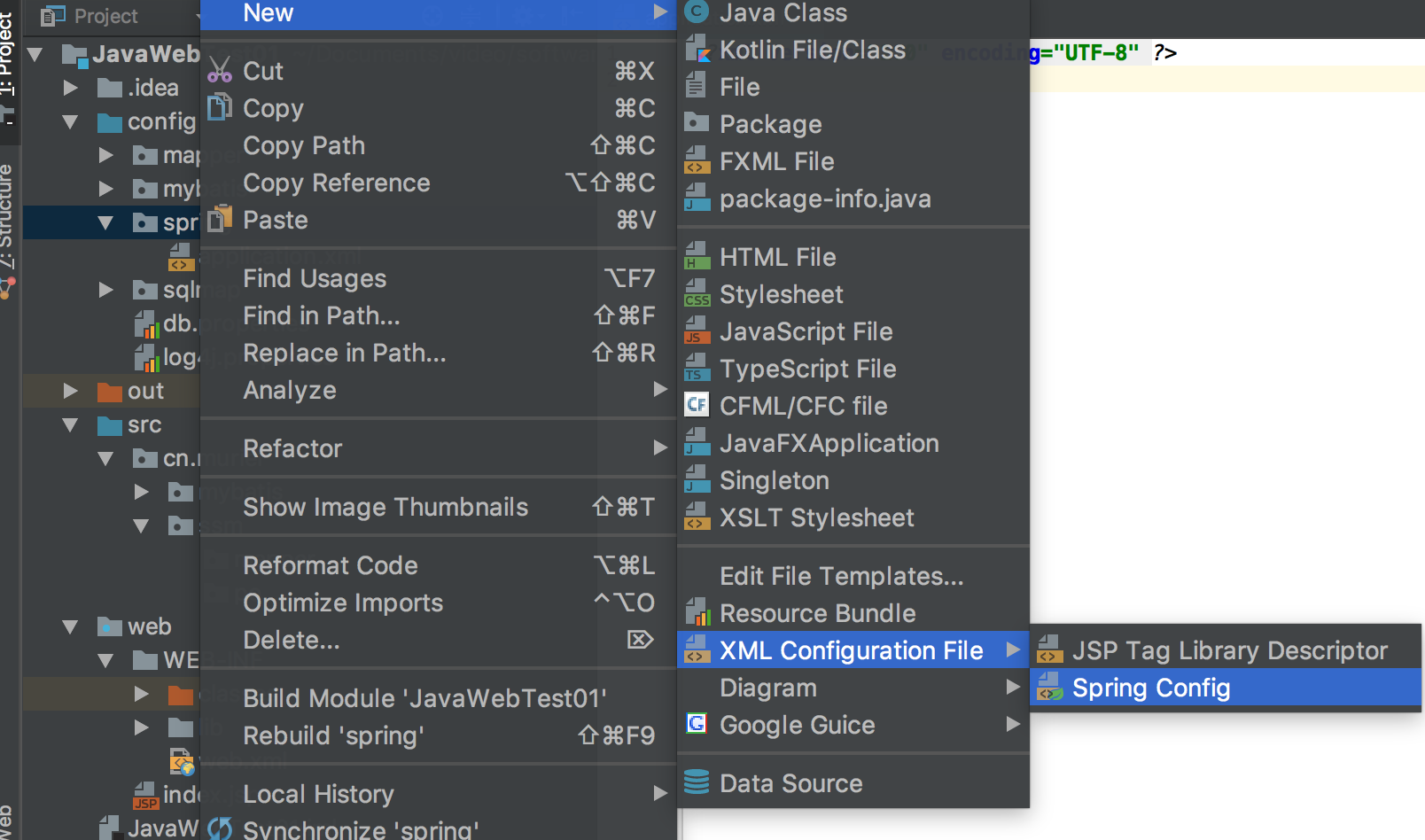mybatis基础(下)
2024-10-20 09:20:32
- mybatis和spring整合
- 需要spring通过单例方式管理SqlSessionFactory
- spring和mybatis整合生成代理对象,使用SqlSessionFactory创建SqlSession
- 持久层的mapper都需要由spring进行管理
- 需要导入的jar包
- 需要建立的文件
- 需要建立的包
- 在applicationContext.xml配置sqlSessionFactory
- 创建applicationContext.xml
- 配置applicationContext.xml
<?xml version="1.0" encoding="UTF-8"?>
<beans xmlns="http://www.springframework.org/schema/beans"
xmlns:xsi="http://www.w3.org/2001/XMLSchema-instance"
xmlns:context="http://www.springframework.org/schema/context"
xsi:schemaLocation="http://www.springframework.org/schema/beans http://www.springframework.org/schema/beans/spring-beans.xsd http://www.springframework.org/schema/context http://www.springframework.org/schema/context/spring-context.xsd"> <!-- 加载配置文件 -->
<context:property-placeholder location="classpath:db.properties"/>
<!-- 数据源,使用dbcp -->
<!--
driverClassName:
url:
username:
password:
maxActive:
maxIdle:
-->
<bean id="dataSource" class="org.apache.commons.dbcp2.BasicDataSource" destroy-method="close">
<property name="driverClassName" value="${jdbc.driver}"/>
<property name="url" value="${jdbc.url}"/>
<property name="username" value="${jdbc.username}"/>
<property name="password" value="${jdbc.password}"/>
<!--<property name="maxActive" value="10"/>-->
<property name="maxIdle" value="5"/>
</bean>
<!-- 配置SqlSessionFactory -->
<!--
class:设置为mybatis-spring.jar中的类
id:唯一表示标识
-->
<bean id="SqlSessionFactory" class="org.mybatis.spring.SqlSessionFactoryBean">
<!-- 加载mybatis的配置文件 -->
<property name="configLocation" value="mybatis/SqlMapConfig.xml"/>
<!-- 加载数据源 -->
<property name="dataSource" ref="dataSource"/> </bean>
</beans>
- 创建applicationContext.xml
- 整合代码及其bug
- 若报找不到org.springframework.dao.support.DaoSupport的类文件
- 导入spring-tx-4.3.5.RELEASE.jar
若报java.lang.ClassNotFoundException: org.apache.commons.pool2.PooledObjectFactory
- 导入commons-pool2-2.6.1.jar
若报java.lang.NoClassDefFoundError: org/springframework/aop/support/AopUtils
- 导入spring-aop-4.3.5.RELEASE.jar
- 若报nested exception is java.lang.NoClassDefFoundError: org/springframework/jdbc/datasource/TransactionAwareDataSourceProxy
- 导入spring-jdbc-4.3.5.RELEASE.jar
- 原生dao
/**
* dao接口实现类需要注入SqlSessionFactory,通过spring进行注入
* 这里通过spring声明配置方式,配置dao的bean
*/
public interface UserDao { public abstract List<User> selectAllUser(); } /**
* UserDao的实现类
*/
public class UserDaoImpl extends SqlSessionDaoSupport implements UserDao { @Override
public List<User> selectAllUser() {
//继承SqlSessionDaoSupport,通过this.getSqlSession()得到sqlSession
SqlSession connection = this.getSqlSession();
List<User> users = connection.selectList("user.selectAllUser"); //方法结束就自动关闭,所以不需要close();
//connection.close();
return users;
}
} <!-- 在applicationContext.xml配置 --> <?xml version="1.0" encoding="UTF-8"?>
<beans xmlns="http://www.springframework.org/schema/beans"
xmlns:xsi="http://www.w3.org/2001/XMLSchema-instance"
xmlns:context="http://www.springframework.org/schema/context"
xsi:schemaLocation="http://www.springframework.org/schema/beans http://www.springframework.org/schema/beans/spring-beans.xsd http://www.springframework.org/schema/context http://www.springframework.org/schema/context/spring-context.xsd"> <!-- 加载配置文件 -->
<context:property-placeholder location="classpath:db.properties"/>
<!-- 数据源,使用dbcp -->
<!--
driverClassName:
url:
username:
password:
maxActive:
maxIdle:
-->
<bean id="dataSource" class="org.apache.commons.dbcp2.BasicDataSource" destroy-method="close">
<property name="driverClassName" value="${jdbc.driver}"/>
<property name="url" value="${jdbc.url}"/>
<property name="username" value="${jdbc.username}"/>
<property name="password" value="${jdbc.password}"/>
<!--<property name="maxActive" value="10"/>-->
<property name="maxIdle" value="5"/>
</bean>
<!-- 配置SqlSessionFactory -->
<!--
class:设置为mybatis-spring.jar中的类
id:唯一表示标识
-->
<bean id="SqlSessionFactory" class="org.mybatis.spring.SqlSessionFactoryBean">
<!-- 加载mybatis的配置文件 -->
<property name="configLocation" value="mybatis/SqlMapConfig.xml"/>
<!-- 加载数据源 -->
<property name="dataSource" ref="dataSource"/> </bean> <!-- 原始dao接口 -->
<bean id="userDao" class="cn.muriel.ssm.dao.impl.UserDaoImpl">
<property name="sqlSessionFactory" ref="SqlSessionFactory"/>
</bean> </beans> <!-- 在userMapper.xml配置 --> <?xml version="1.0" encoding="UTF-8" ?>
<!-- 此时您可能想知道SqlSession或Mapper类究竟执行了什么。
MyBatis提供的全套功能可以通过使用多年来MyBatis流行的基于XML的映射语言来实现。
如果您以前使用过MyBatis,那么您将很熟悉这个概念,但是对XML映射文档进行了大量改进,以后会很清楚。 -->
<!DOCTYPE mapper
PUBLIC "-//mybatis.org//DTD Mapper 3.0//EN"
"http://mybatis.org/dtd/mybatis-3-mapper.dtd">
<!-- namespace命名空间。作用对sql进行分类化管理,理解sql隔离
注意:使用mapper代理方法开发,namespace有特殊重要的作用 -->
<mapper namespace="cn.muriel.ssm.dao.UserDao"> <select id="selectAllUser" resultType="cn.muriel.mybatis.po.User"> select * from user </select>
</mapper> <!-- 测试 -->
public class TestUtil { private static ApplicationContext applicationContext; //在setUp这个方法得到spring容器
public static void main(String[] args) { applicationContext = new ClassPathXmlApplicationContext("classpath:spring/applicationContext.xml"); UserDao userDao = (UserDao) applicationContext.getBean("userDao");
JSONArray sendJson = JSONArray.fromObject(userDao.selectAllUser());
System.out.println(sendJson + ""); }
} - 代理mapper
/**
* dao接口实现类需要注入SqlSessionFactory,通过spring进行注入
* 这里通过spring声明配置方式,配置dao的bean
*/
public interface UserMapper { public abstract List<User> selectAllUser(); } /**
* UserDao的实现类
*/
public class UserDaoImpl extends SqlSessionDaoSupport implements UserMapper { @Override
public List<User> selectAllUser() {
//继承SqlSessionDaoSupport,通过this.getSqlSession()得到sqlSession
SqlSession connection = this.getSqlSession();
List<User> users = connection.selectList("user.selectAllUser"); //方法结束就自动关闭,所以不需要close();
//connection.close();
return users;
}
} <!-- 在applicationContext.xml配置 --> <?xml version="1.0" encoding="UTF-8"?>
<beans xmlns="http://www.springframework.org/schema/beans"
xmlns:xsi="http://www.w3.org/2001/XMLSchema-instance"
xmlns:context="http://www.springframework.org/schema/context"
xsi:schemaLocation="http://www.springframework.org/schema/beans http://www.springframework.org/schema/beans/spring-beans.xsd http://www.springframework.org/schema/context http://www.springframework.org/schema/context/spring-context.xsd"> <!-- 加载配置文件 -->
<context:property-placeholder location="classpath:db.properties"/>
<!-- 数据源,使用dbcp -->
<!--
driverClassName:
url:
username:
password:
maxActive:
maxIdle:
-->
<bean id="dataSource" class="org.apache.commons.dbcp2.BasicDataSource" destroy-method="close">
<property name="driverClassName" value="${jdbc.driver}"/>
<property name="url" value="${jdbc.url}"/>
<property name="username" value="${jdbc.username}"/>
<property name="password" value="${jdbc.password}"/>
<!--<property name="maxActive" value="10"/>-->
<property name="maxIdle" value="5"/>
</bean>
<!-- 配置SqlSessionFactory -->
<!--
class:设置为mybatis-spring.jar中的类
id:唯一表示标识
-->
<bean id="SqlSessionFactory" class="org.mybatis.spring.SqlSessionFactoryBean">
<!-- 加载mybatis的配置文件 -->
<property name="configLocation" value="mybatis/SqlMapConfig.xml"/>
<!-- 加载数据源 -->
<property name="dataSource" ref="dataSource"/> </bean> <!-- mapper配置 -->
<!--
class为mybatis-spring.jar下的类
MapperFactoryBean:根据mapper接口生成代理对象
-->
<!-- UserMapper.java和userMapper.xml在同一个包下 -->
<bean id="userMapper" class="org.mybatis.spring.mapper.MapperFactoryBean">
<property name="mapperInterface" value="cn.muriel.ssm.mapper.UserMapper"/>
<!-- 若ref改为value,则报ConversionNotSupportedException -->
<property name="sqlSessionFactory" rel="SqlSessionFactory"/>
</bean> </beans> <!-- 在userMapper.xml配置 --> <?xml version="1.0" encoding="UTF-8" ?>
<!-- 此时您可能想知道SqlSession或Mapper类究竟执行了什么。
MyBatis提供的全套功能可以通过使用多年来MyBatis流行的基于XML的映射语言来实现。
如果您以前使用过MyBatis,那么您将很熟悉这个概念,但是对XML映射文档进行了大量改进,以后会很清楚。 -->
<!DOCTYPE mapper
PUBLIC "-//mybatis.org//DTD Mapper 3.0//EN"
"http://mybatis.org/dtd/mybatis-3-mapper.dtd">
<!-- namespace命名空间。作用对sql进行分类化管理,理解sql隔离
注意:使用mapper代理方法开发,namespace有特殊重要的作用 -->
<mapper namespace="cn.muriel.ssm.mapper.UserMapper"> <select id="selectAllUser" resultType="cn.muriel.mybatis.po.User"> select * from user </select>
</mapper> <!-- 测试 -->
public class TestUtil { private static ApplicationContext applicationContext; //在setUp这个方法得到spring容器
public static void main(String[] args) { applicationContext = new ClassPathXmlApplicationContext("classpath:spring/applicationContext.xml"); UserMapper userMapper = (UserMapper) applicationContext.getBean("userMapper");
JSONArray sendJson = JSONArray.fromObject(userMapper.selectAllUser());
System.out.println(sendJson + ""); }
} - mapper的扫描配置
/**
* dao接口实现类需要注入SqlSessionFactory,通过spring进行注入
* 这里通过spring声明配置方式,配置dao的bean
*/
public interface UserMapper { public abstract List<User> selectAllUser(); } /**
* UserDao的实现类
*/
public class UserDaoImpl extends SqlSessionDaoSupport implements UserMapper { @Override
public List<User> selectAllUser() {
//继承SqlSessionDaoSupport,通过this.getSqlSession()得到sqlSession
SqlSession connection = this.getSqlSession();
List<User> users = connection.selectList("user.selectAllUser"); //方法结束就自动关闭,所以不需要close();
//connection.close();
return users;
}
} <!-- 在applicationContext.xml配置 --> <?xml version="1.0" encoding="UTF-8"?>
<beans xmlns="http://www.springframework.org/schema/beans"
xmlns:xsi="http://www.w3.org/2001/XMLSchema-instance"
xmlns:context="http://www.springframework.org/schema/context"
xsi:schemaLocation="http://www.springframework.org/schema/beans http://www.springframework.org/schema/beans/spring-beans.xsd http://www.springframework.org/schema/context http://www.springframework.org/schema/context/spring-context.xsd"> <!-- 加载配置文件 -->
<context:property-placeholder location="classpath:db.properties"/>
<!-- 数据源,使用dbcp -->
<!--
driverClassName:
url:
username:
password:
maxActive:
maxIdle:
-->
<bean id="dataSource" class="org.apache.commons.dbcp2.BasicDataSource" destroy-method="close">
<property name="driverClassName" value="${jdbc.driver}"/>
<property name="url" value="${jdbc.url}"/>
<property name="username" value="${jdbc.username}"/>
<property name="password" value="${jdbc.password}"/>
<!--<property name="maxActive" value="10"/>-->
<property name="maxIdle" value="5"/>
</bean>
<!-- 配置SqlSessionFactory -->
<!--
class:设置为mybatis-spring.jar中的类
id:唯一表示标识
-->
<bean id="SqlSessionFactory" class="org.mybatis.spring.SqlSessionFactoryBean">
<!-- 加载mybatis的配置文件 -->
<property name="configLocation" value="mybatis/SqlMapConfig.xml"/>
<!-- 加载数据源 -->
<property name="dataSource" ref="dataSource"/> </bean> <!-- mapper批量扫描,从mapper包中扫描出mapper接口,自动创 建代理对象并且在spring容器中注册 -->
<!-- 自动扫描出来的mapper的bean的id为mapper类名(首字母小写) -->
<bean class="org.mybatis.spring.mapper.MapperScannerConfigurer">
<!--
指定扫描的包名
指定mapper接口的包名,mybatis自动扫描包下边所以mapper接口进行加载
遵循一些规范:需要将mapper接口类名和mapper.xml映射文件名称保持一致,且在一个目录中
如果扫描多个包,每个包中间使用逗号分隔
-->
<property name="basePackage" value="cn.muriel.ssm.mapper"/>
<!-- 数据源 -->
<property name="sqlSessionFactoryBeanName" value="SqlSessionFactory"/>
</bean> </beans> <!-- 在userMapper.xml配置 --> <?xml version="1.0" encoding="UTF-8" ?>
<!-- 此时您可能想知道SqlSession或Mapper类究竟执行了什么。
MyBatis提供的全套功能可以通过使用多年来MyBatis流行的基于XML的映射语言来实现。
如果您以前使用过MyBatis,那么您将很熟悉这个概念,但是对XML映射文档进行了大量改进,以后会很清楚。 -->
<!DOCTYPE mapper
PUBLIC "-//mybatis.org//DTD Mapper 3.0//EN"
"http://mybatis.org/dtd/mybatis-3-mapper.dtd">
<!-- namespace命名空间。作用对sql进行分类化管理,理解sql隔离
注意:使用mapper代理方法开发,namespace有特殊重要的作用 -->
<mapper namespace="cn.muriel.ssm.mapper.UserMapper"> <select id="selectAllUser" resultType="cn.muriel.mybatis.po.User"> select * from user </select>
</mapper> <!-- 测试 -->
public class TestUtil { private static ApplicationContext applicationContext; //在setUp这个方法得到spring容器
public static void main(String[] args) { applicationContext = new ClassPathXmlApplicationContext("classpath:spring/applicationContext.xml"); UserMapper userMapper = (UserMapper) applicationContext.getBean("userMapper");
JSONArray sendJson = JSONArray.fromObject(userMapper.selectAllUser());
System.out.println(sendJson + ""); }
}
- 若报找不到org.springframework.dao.support.DaoSupport的类文件
- 需要建立的文件
最新文章
- Tomcat server.xml配置示例
- [转]spring beans.xml
- sublimetext3官网安装
- 20155215 2016-2017-2 《Java程序设计》第5周学习总结
- 解密Lazy<T>
- iOS 计时器三种定时器的用法NSTimer、CADisplayLink、GCD
- HTML/CSS 常用单词整理
- [BJOI2019] 删数
- 我所知道的JavaScript中判断数据类型
- Java线程小刀牛试
- C#.NET 大型通用信息化系统集成快速开发平台 4.0 版本 - 客户常用问题回答
- windows下安装Mysql—图文详解
- Spring的Java配置方式—@Configuration和@Bean实现Java配置
- centos7发行版号对应基于RHEL Source(版本)对照表
- godaddy.com 都转到 www.dnspod.cn
- update moudle 调用方式
- Java重写toString和泛型的使用
- Android UiAutomator UiDevice API
- PHP搞笑注释代码-佛祖配美女
- 定时模块app_timer用法及常见问题—nRF5 SDK模块系列二




